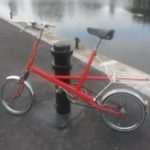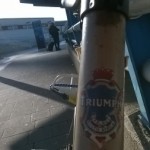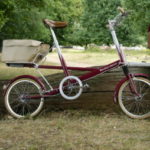This group is open to all registered members of the site.
tail pipe cut off
- This topic has 17 replies, 7 voices, and was last updated 8 years, 10 months ago by
Alexander Johnston.
-
AuthorPosts
-
April 25, 2016 at 9:41 pm #5113
 Des GibbonsParticipant
Des GibbonsParticipantI havent heard of any fails to be honest, if it makes you feel better you could weld a small triangle to brace it or somehow use a smaller tube inserted down the hole to strengthen it that way, sure i have seen someone squash a bit of seatube down there before if you flatten the tube to match the shape of the flattened oval original tube but i am sure you will be fine as long as your not using it like a bmx.
April 26, 2016 at 5:01 pm #5114 IanParticipant
IanParticipantQuite a few have failed. But we are talking about 50 year old bicycle frames and who knows how much damage they may have suffered prior to the seat post collapsing?
One was Julian K’s chromed Speedsix – which was made with a docked tail. Others get docked and haven’t collapsed. So it’s clearly a bit of a gamble.
April 26, 2016 at 8:49 pm #5115 david jamesParticipant
david jamesParticipanttig weld a 3mm thick plate as an end cap, it’ll be stronger than it was originally
April 27, 2016 at 9:12 am #5116 IanParticipant
IanParticipantHow will welding anything, by any method, stop the seat post devoid of support struts, from collapsing david james?
April 27, 2016 at 2:43 pm #5117Bob Cordon Champ
MemberTail pipe cut off? Seek gender re-assignment surgery!
Should you wish to see a disastrous welded repair, email bobcordonchamp@gmail.com Done years ago and ruined a carefully used, very early, Standard. Everything salvaged but the frame.
Bob CC.April 27, 2016 at 4:21 pm #5118 david jamesParticipant
david jamesParticipantit’s not rocket science, for a start i’m assuming it’s just the tail pipe that has been cut off (that’s how it reads) not any of the struts.where the pipe passes through the vertical seatpost you have a hole at the front and the back cut out at the most stressed part of the cant post, the walls of the horizontal tube must put some of that stiffness back, the only way they can do this is by the resistance of the walls to compression/tension forces as it is all brazed together these forces will be transmitted by the seatpost.if you cut the horizontal tube near to where a load is applied it will not be as strong as if the load was applied in the middle.a bit like standing on a plastic rainwater pipe on the ground, you push on the end it will squash a lot easier than if you tread in the middle, if you put an end plate welded all round it is almost as good as a continuous tube if you apply a load at the end.i would guess this is why the moultons with factory shortened tailpipes left 50mm or so after the seatpost.i might add i design steel framed buildings for a living so i know a little bit about structures!
April 30, 2016 at 10:15 am #5120 CLIVE FENNERParticipant
CLIVE FENNERParticipantAfter stripping off the old paint and priming the frame I have noticed two hairline cracks either side of the joint at the seat tube crossbar junction. Is this economically repairable? If so how ?
May 2, 2016 at 5:30 pm #5121 david jamesParticipant
david jamesParticipantcan you post a photo, i know it’s not easy on this site!
May 3, 2016 at 7:27 am #5122 CLIVE FENNERParticipant
CLIVE FENNERParticipantThe frame is not with me its at my brother in laws, he is restoring it. The cracks are so fine l don’t think they will show up in a photo. I’ll try taking pictures at the weekend. He has thought about drilling holes along the cracks & then brazing the holes.
May 10, 2016 at 6:47 pm #5123 CLIVE FENNERParticipant
CLIVE FENNERParticipantThe cracks have been widened to allow a weld to be put in, hopefully this will cure it.
May 10, 2016 at 8:47 pm #5124 david jamesParticipant
david jamesParticipantif you drill a small hole at the end of the crack it might help, stops it carrying on.same principle as the comet airliner!
May 10, 2016 at 9:11 pm #5125 david jamesParticipant
david jamesParticipantsomeone has written in the f frame group that the original rack struts were structural, ie to brace the the cant seat post and the purpose built models (safari etc) with docked tails had an extra tube inside the seatpost tube to strengthen it, that could explain the failures
June 3, 2016 at 10:07 pm #5126Bruce
Participantthe structure isn’t very well triangulated even if the carrier struts are present (and they vary in how well they can brace everything because they don’t all mount the same way to the rest of the bike).
Also it is fair to say that the quality of the brazing may well have been a bit, uh, ‘variable’ when they were rushing to meet demand in the early days. It is very easy to embrittle the steel near a brazed joint with a little too much time/temperature, and/or wrong cooling rate.
It is also possible for the pierced holes to have tiny pre-existing cracks in the edge of the piercing, where you can’t see them. Such defects can propagate in service. [Amazingly I discovered recently that one the world’s largest makers of quality bicycles has been making frames that are systematically weak in fatigue for similar reasons in recent years…]
BTW simply brazing up cracks won’t usually make for a reliable repair; some form of lap joint with a reinforcement is usually required.
Often it is possible to make a satisfactory repair using MIG or TIG welding but these processes are very badly affected by any nearby braze metal remaining from the original joint. Again it is likely that the frame will benefit from reinforcement of some kind.
It seems to me that most of the S1 Moultons that I have seen/owned have not done that many miles. Given how many of them break (despite this?) I find it somewhat worrying.
cheers
June 4, 2016 at 4:39 pm #5127Alexander Johnston
ParticipantF frame Moultons are now about 50 years old so structural issues are to be expected. Note that the original F frame design would not pass modern design and safety standards.
Also In the mid ‘sixties the average man weighed about 10.5 stone compared with over 13 stone today.
If you want a safer bike ride a S2 preferably made by Raleigh.June 6, 2016 at 4:31 pm #5128Bob Cordon Champ
MemberAgreed. One of the complaints made by bicycle shops in the first decade of Moultons was that they ‘wore out’ quickly. Arguably, some parts of the design – the rear suspension, for instance – were over-complex, the later Mini range being much simpler and working well, and the F-frames were reckoned to be prone to cracking even then.
As to longevity, my Sunbeam ‘Golden’ is 106 years old and running well, having been in use all of its life so far, and still on its original chain and running -gear. Bob CC.June 6, 2016 at 8:19 pm #5129 david jamesParticipant
david jamesParticipantone of the advantages of steel over aluminium or carbon fibre is that it will not suddenly fail,look for the warning signs, with rear rear mk1 forks a leaning wheel, with the seat post will most likely lean/show cracks before failing.
June 6, 2016 at 9:26 pm #5130Alexander Johnston
ParticipantHi Bob
106 years old: that’s impressive. Even more impressive if you bought it new!
The issues with the S1 design was obviously recognised by Moulton or else they wouldn’t have progressed to the S2 with stronger forks and the rotated seat tube as on later Deluxes
(about 1966) and Majors (1967 to 1969).
Interestingly the Automatic which was only made in 1966 has a brazed S2 frame incorporating the rotated seat tube and the latest and strongest of the Series 1 rear forks – the same as those fitted to “S” models with Series 1 rear forks.
There’s a photo of these rear forks on page 43 of Issue 107 of the Moultoneer and they look bomb-proof. -
AuthorPosts
- You must be logged in to reply to this topic.


